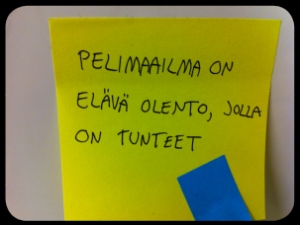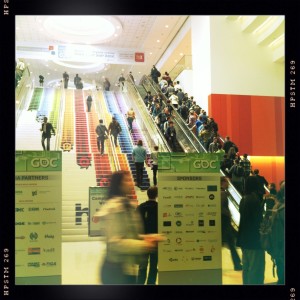Many in my network publish highlights of the past year typically in January, or even in December. For me, the annual reflections have been a great way to start the year and celebrate the recent achievements instead of jumping right into the extensive list of dreams, hopes and concrete to-dos. It is important to stop and reflect, appreciate your past and lay the mental groundwork for new things ahead.
This year, I had a harder-than-usual descent to work life after the holidays. It has been quite an exhaustive year as a new parent balancing work and life in the pandemic era. Even the holidays themselves were filled with new kinds of stress factors. My first work week of the year 2022 went past too fast and while all the deadlines kicked in, it took me nearly two months to get my reflections into a publishable format. But 2021 was a special year, and I am not a person that gives up easily, so here my highlights!

I know it is a bit dirty to quantify one’s academic achievements, but it is definitely part of the world that we game scholars inhabit. While game developers crunch the numbers of the download rates, peak online players, user acquisition costs, or for instance click-through rates — we follow the slow development of the impact of our research papers.
In 2021 I improved my academic metrics from 180+ citations (2020) to 230+ citations (2021). I follow my numbers from Google Scholar, so they keep on piling up while the Google “robots” find more papers from each year. While I have had one or two valleys on my statistics, it is definitely nice to see an upward trend for a few years in a row.
For me, improving metrics has been a sort of a maturity test: after 15+ years in academia, am I able to make sure that my research is noticed and my contribution is used? Do I understand the networks of academic communities, and how to, not only report your findings, but to also make sure that my work is spread around? While there are numerous tactics and lessons that I have learned throughout the years, and more so in the past year or so, one of the biggest factors for the citation count is the sheer number of (new) publications.
For a long time now, I have been aiming to publish 2 to 4 academic papers per year, and I was really stressed out whether it would be possible after transitioning to parent life. I ended up publishing 9 articles, out of which 7 were peer-reviewed research articles, one a book review and one a preface for a book (check out Game Designer Confessions by Konsta Klemetti & Harro Grönberg from Amazon).
Many of my contributions are published within a small scale special interest academic conference ICGJ. While the ICGJ conference has a relatively low impact factor due to its age and breadth of its niche, it has been my go to venue for game jam research. At this stage of game jam studies, I find it important to share the research results with the right community — Instead of trying to aim venues rated higher. It also helps that ICGJ utilizes ACM Digital Library, allowing people outside the ICGJ community to find our work with ease. I got really lucky in 2021 and got several papers accepted. I was also happy to receive two best paper awards.
I have to admit that publishing 7 research papers in a single year feels like a small miracle as a new mom. I am grateful for the support of the community surrounding me, and I will try to remember to pay this back to other new moms in our communities. And while I am happy to also support new dads, I am especially emphatic to the ones that have had their bodies stretched and scarred in the process. Academia, especially tech academia, is still pretty harsh for women and it is not the most friendly environment to be pregnant, breastfeed, teach small kids to sleep, and to take care of your own recovery. Support is really important.
I have titled 2021 “A Very Noita Year”. I am sure that I will be excited about the work I did in collaboration with The Finnish Museum of Games and indie game company Nolla Games, even years after 2021. Noita – The Long Journey of a Game Idea exhibition, was showcased at the Finnish Museum of Games from 4th September to 12th December. The curatorial research team included me, museum researcher Niklas Nylund and my former student Riina Ojanen. The project was a first of its kind for me as a combination of praxiological research and exhibition curating. The process involved over 100 hours of gameplay of Noita, mostly streamed live on Twitch. I also regularly started my days with watching other content creators streaming their Noita runs. It has been a long dream of mine to utilize streaming in my research projects.



In the end, the project consisted of a great selection of varied information sources: multiple interviews with the development team, engagement of the player and content creator community of Noita, physical materials such as development notes and lists, sketch book, one development diary, multiple mockup images, videos, trailers, 23 early prototypes, 180+ builds of the game, as well as other materials provided by the development team and what we found online.
In the spirit of The Finnish Museum of Games, the exhibition also featured two playable prototypes/games from the development journey: one really early prototype (Wizard Physics) and the Steam Early Access version of Noita. We have a couple of research papers lined up and hopefully will be able to publish the academic side of the results somewhere between 2022 and 2024. The project had really interesting research findings from the praxiological perspective.
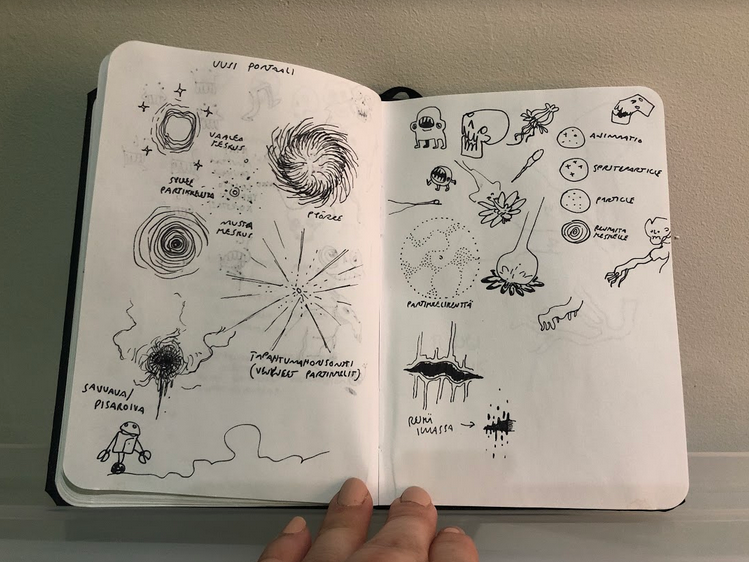
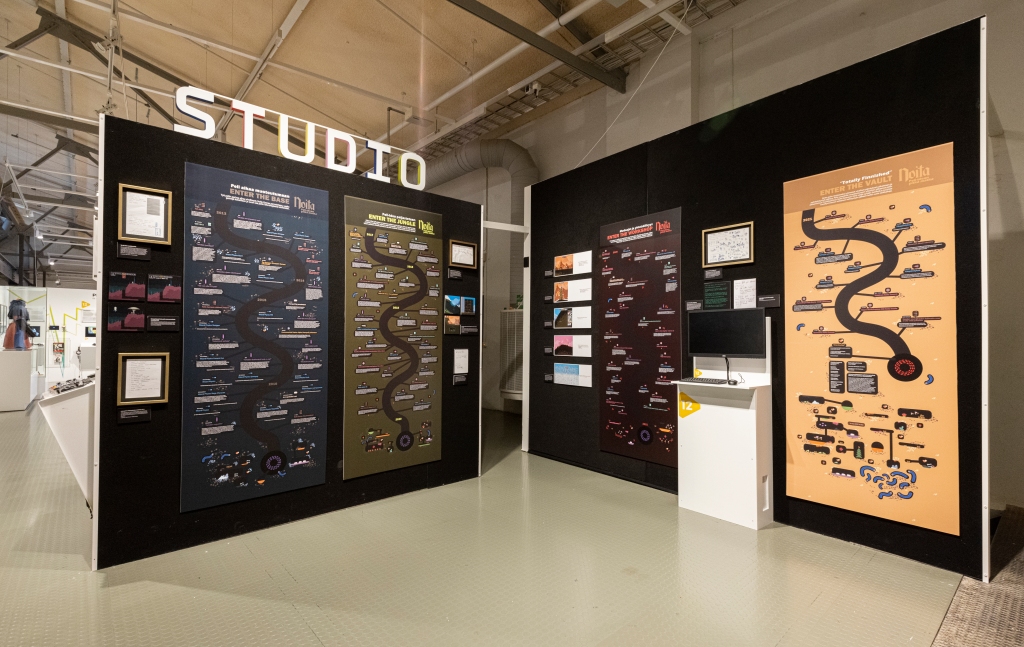
I also took on an extensive illustration work for the Noita exhibition. We ended up dividing the development journey of Noita into seven timelines. All these timelines were visually presented in the exhibition space as 80 x 200 cm posters surrounded with carefully picked objects, notes and drafts. Each timeline was themed according to a level in the actual game. I created stylized graphics iconizing characters and objects originally created as pixel art by the Noita’s lead artist Arvi Teikari. While I was happy with the overall look of the visuals, I found the development of the pixel-to-vector translation the most fascinating. I find the exhibition illustrations to be my most advanced and ambitious graphical work since 2003, when I started my own company.


Sometimes I feel that I have become a bit of an overused face or voice on Finnish media. While it can be flattering to be invited to share your insights, it often steals time from other work. Not all media work is visible: I sometimes help journalists to find suitable experts or educate them over the phone with impromptu lectures on games. I take this as our service for the society and am happy to help, as educating the masses on the plurality and complexity of game phenomena will also help our scholarly work in the long run. This year the Finnish game industry hit one hallmark with our national media: we got a full hour of live prime time on the national broadcasting company YLE’s TV2 talk show Kulttuuricocktail, labeled as culture programming. I was humbled to represent our professional communities together with the legendary Sami Järvi (Sam Lake) from Remedy. The title of the talk show was “Videogames as a super art form”. The show was in Finnish and is available as a recording: https://areena.yle.fi/1-50834543.

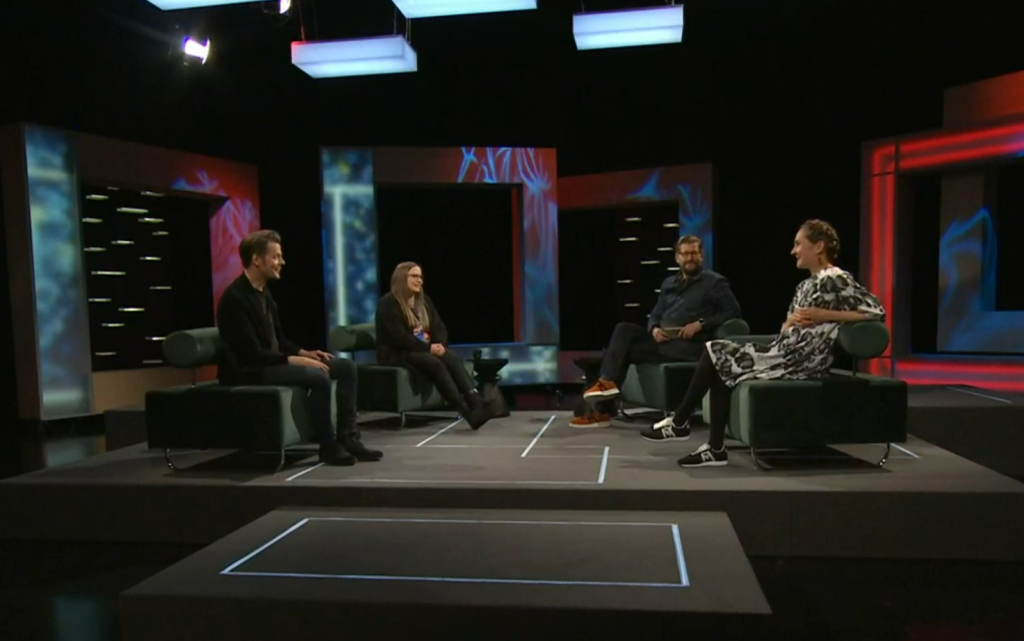
Perhaps the biggest highlight of the year was the launch of our Game Design Praxiology Group (with the letter i, not e!!). We have been existing for a while now, sharing our pet-peeves of studying games from the praxiological point of view, but it is time to come out from the stealth mode. Our group currently has 8 members including me. We are versatile: we cover different nationalities from Finns to Swedes, to Brits to South Koreans. Our backgrounds are in philosophy, game studies, history, art education, media studies, and even physics. We study games as art, cultural diversity of game development, translation processes of expertise in game development, game jams, game development tools and pipelines, game art education, development of quantum games, tools for hybrid play, epistemic communities of game developers as well as language(s) of game design just to name a few general topics. Many of the members of our group have experience in the game industry prior (or parallel with) their academic careers.
Currently there are multiple specific PhD research projects ongoing in our Praxiology group. Solip Park is studying game expats at the Finnish game industry, Ed Morrell is taking an interesting perspective on studying game making through asset creation and design fiction, Laura Piispanen is looking at quantum game design and development of science games, and Heikka Valja is looking at game development from the art education point of view. I am super happy to be able to supervise these projects!
Our senior members, Ville Kankainen and Ylva Grufstedt, are working on their postdoctoral research ideas and projects. Ville is currently finalizing his doctoral studies on hybrid play at the Tampere University, and his insights to hybrid and analog game design is very valuable for our group. Our Swedish leg of the team, Dr. Ylva Grufstedt, is working on her postdoctoral studies and helping Aalto’s online learning services to understand the challenges of (educational) game development pipeline(s). Our game development lecturer at Aalto University, Miikka Junnila, is developing his research on the dialogue between theme and mechanics in game design.
It is great to have this group, and we are currently applying for funding from several sources. We run monthly game research seminars mixed with other game groups at Aalto, focusing especially on our shared interest in game design research. We are always looking for interesting academic and industry collaborators.


Apart from these highlights, life in 2021 was pretty monotonous as the world has been in a constant stream of limitations and lock-downs. Me and my husband worked from home and avoided burdening our small family with Covid-19 or other viruses. Despite that, I got new glasses (to cheer me up) and enjoyed daily walks with my son. I tried to keep my walks interesting by practicing some impromptu phone calls to colleagues around the globe while the toddler was sleeping. I highly recommend this to others! Unfortunately my son’s sleeping pattern changed during the Autumn, so these walks are now in the past.

At the end of the year 2021, I got myself an Oura ring and new Apple Watch to help make my habits visible to me. While I do feel that I have learned a lot in my life, I am still on my journey to learn how to take better care of myself.

The first year of the pandemic was run in survival mode. The second year has felt like squeezing the final juices from the fruits planted in the pre-pandemic time. We desperately need carefree face-to-face interactions, wandering around the campus, coffee breaks, corridor conversations, and conference trips to keep research fresh and our sanity intact.
2021 was a good year to reflect on, but it was a hard year to go through.

 The book without the articles is available online at:
The book without the articles is available online at: 












